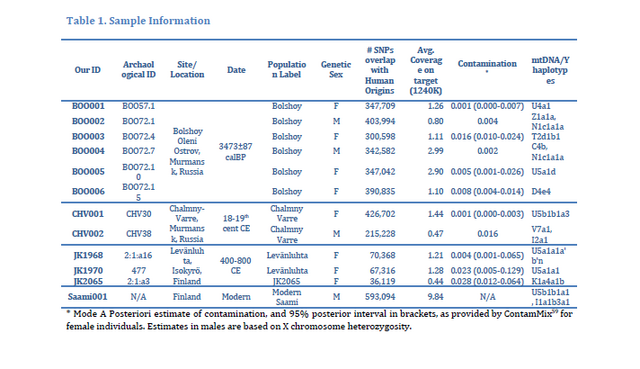In this study we present new genome-wide data from 11 individuals from Finland and the Russian Kola Peninsula who lived between 3,500 to 200 years ago. In addition, we present a new high-coverage genome from a modern Saami individual for whom low coverage data was published previously 1. Our results suggest that a new genetic component with strong Siberian affinity first arrived in Europe around 4,000 years ago, as observed in our oldest analysed individuals from northern Russia, and that the gene pool of modern north-eastern Europeans in general, and speakers of Uralic languages in particular, is the result of multiple admixture events between Eastern and Western sources since that first appearance. Additionally, we gain further insights into the genetic history of the Saami in Finland, by showing that during the Iron Age, close genetic relatives of modern Saami lived in an area much further south than their current geographic range.
The Siberian ancestry seen in EHG probably corresponds to a previously reported affinity towards Ancient North Eurasians (ANE) 2,24, which also comprises part of the ancestry of Nganasans. Interestingly, results from uniparentally-inherited markers (mtDNA and Y chromosome) as well as certain phenotypic SNPs also show Siberian signals in Bolshoy: mtDNA haplogroups Z1, C4 and D4, common in modern Siberia 18,25,26 , in individuals BOO002, BOO004 and BOO006, respectively (confirming previous findings 18), as well as Y-chromosomal haplotype N1c1a1a (N-L392) in individuals BOO002 and BOO004. Haplogroup N1c, to which this haplotype belongs, is the major Y chromosomal lineage in modern North-East Europe and European Russia, especially in Uralic speakers, for example comprising as much as 54% of Eastern Finnish male lineages today 27.
Notably, this is the earliest known occurrence of Y-haplogroup N1c in Fennoscandia. Additionally, within the Bolshoy population we observe the derived allele of rs3827760 in the EDAR gene, which is found in near-fixation in East Asian and Native American populations but is extremely rare elsewhere 28, and has been linked to phenotypes related to tooth shape 29 and hair morphology 30,31 (Supplementary Table 7). Scandinavian hunter-gatherers from Motala in Sweden have also been found to carry haplotypes associated with this allele 4. Finally, we see high frequencies of haplotypes associated with diets rich in high poly-unsaturated fatty acids, on the FADS genes 4,32,33. The FADS haplotype observed here has previously been linked with Greenlanders 32, and is found in lower frequencies within Europe 33.


